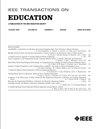人工智能时代的网络安全教育:新颖的主动协作学习范式
IF 2
2区 工程技术
Q2 EDUCATION, SCIENTIFIC DISCIPLINES
引用次数: 0
摘要
贡献:我们提出了一种新颖的主动协作式学习范式,以吸引不同背景的学习者参与,并有效地保留和迁移多学科人工智能(AI)-网络安全知识。具体来说,拟议的学习范式包括1) 沉浸式学习环境,通过使用有形物体构建学习模型,激励学生在真实世界的网络安全场景中探索人工智能/机器学习(ML)的发展;以及 2) 基于游戏式学习和社会建构主义的协作式学习活动,设计积极主动的教育范式。背景:越来越多的证据表明,人工智能技术可以被操纵、规避和误导,从而产生新的、深远的安全影响。要培养一支了解人工智能技术在网络安全领域的实用性、局限性和最佳实践的合格网络队伍,在教育和培训方面还存在差距。为满足需求,我们已努力纳入一套全面的课程。但要有效地教育学生了解人工智能与网络安全之间的相互作用,仍然存在重大挑战。预期成果:在安全漏洞、隐私侵犯和人工智能变得司空见惯的新时代,提出了一种新颖的主动协作学习范式,以教育和培训合格的网络劳动力。应用设计:这一学习范式的开发基于以技术为媒介的学习和社会建构主义的教学方法。研究结果:虽然研究工作仍在进行中,但原型学习范式在促进学习者参与人工智能应用学习方面取得了令人鼓舞的成果。本文章由计算机程序翻译,如有差异,请以英文原文为准。
Cybersecurity Education in the Age of Artificial Intelligence: A Novel Proactive and Collaborative Learning Paradigm
Contribution: A novel proactive and collaborative learning paradigm was proposed to engage learners with different backgrounds and enable effective retention and transfer of the multidisciplinary artificial intelligence (AI)-cybersecurity knowledge. Specifically, the proposed learning paradigm contains: 1) an immersive learning environment to motivate the students for exploring AI/ machine learning (ML) development in the context of real-world cybersecurity scenarios by constructing learning models with tangible objects and 2) a proactive education paradigm designed with the use of collaborative learning activities based on game-based learning and social constructivism. Background: Increasing evidence shows that AI techniques can be manipulated, evaded, and misled, which can result in new and profound security implications. There is an education and training gap to foster a qualified cyber-workforce that understands the usefulness, limitations, and best practices of AI technologies in the cybersecurity domain. Efforts have been made to incorporate a comprehensive curriculum to meet the demand. There still remain essential challenges for effectively educating students on the interaction of AI and cybersecurity. Intended Outcomes: A novel proactive and collaborative learning paradigm is proposed to educate and train a qualified cyber-workforce in this new era where security breaches, privacy violations, and AI have become commonplace. Application Design: The development of this learning paradigm is grounded in the pedagogical approaches of technology-mediated learning and social constructivism. Findings: Although the research work is still ongoing, the prototype learning paradigm has shown encouraging results in promoting the learners’ engagement in applied AI learning.
求助全文
通过发布文献求助,成功后即可免费获取论文全文。
去求助
来源期刊

IEEE Transactions on Education
工程技术-工程:电子与电气
CiteScore
5.80
自引率
7.70%
发文量
90
审稿时长
1 months
期刊介绍:
The IEEE Transactions on Education (ToE) publishes significant and original scholarly contributions to education in electrical and electronics engineering, computer engineering, computer science, and other fields within the scope of interest of IEEE. Contributions must address discovery, integration, and/or application of knowledge in education in these fields. Articles must support contributions and assertions with compelling evidence and provide explicit, transparent descriptions of the processes through which the evidence is collected, analyzed, and interpreted. While characteristics of compelling evidence cannot be described to address every conceivable situation, generally assessment of the work being reported must go beyond student self-report and attitudinal data.
 求助内容:
求助内容: 应助结果提醒方式:
应助结果提醒方式:


